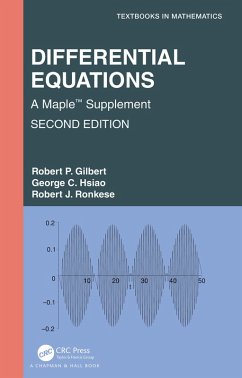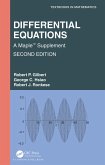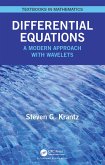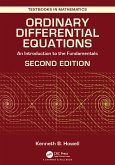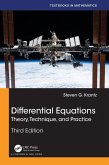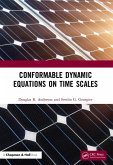Differential Equations (eBook, PDF)
A Maple(TM) Supplement


Alle Infos zum eBook verschenken

Differential Equations (eBook, PDF)
A Maple(TM) Supplement
- Format: PDF
- Merkliste
- Auf die Merkliste
- Bewerten Bewerten
- Teilen
- Produkt teilen
- Produkterinnerung
- Produkterinnerung

Hier können Sie sich einloggen

Bitte loggen Sie sich zunächst in Ihr Kundenkonto ein oder registrieren Sie sich bei bücher.de, um das eBook-Abo tolino select nutzen zu können.
This book illustrates how MAPLE(TM) can be used to supplement a standard, elementary text in ordinary and partial differential equation. The authors are firm believers in the teaching of mathematics as an experimental science where the student does numerous calculations and then synthesizes these experiments into a general theory. The goal of the book is to teach the students enough about the computer algebra system MAPLE(TM) so that it can be used in an investigative way. This book was developed through ten years of instruction in the differential equations course.
- Geräte: PC
- mit Kopierschutz
- eBook Hilfe
![Differential Equations (eBook, ePUB) Differential Equations (eBook, ePUB)]() Robert P. GilbertDifferential Equations (eBook, ePUB)52,95 €
Robert P. GilbertDifferential Equations (eBook, ePUB)52,95 €![Differential Equations (eBook, PDF) Differential Equations (eBook, PDF)]() Steven KrantzDifferential Equations (eBook, PDF)46,95 €
Steven KrantzDifferential Equations (eBook, PDF)46,95 €![Ordinary Differential Equations (eBook, PDF) Ordinary Differential Equations (eBook, PDF)]() Kenneth B. HowellOrdinary Differential Equations (eBook, PDF)46,95 €
Kenneth B. HowellOrdinary Differential Equations (eBook, PDF)46,95 €![Differential Equations (eBook, PDF) Differential Equations (eBook, PDF)]() Steven G. KrantzDifferential Equations (eBook, PDF)88,95 €
Steven G. KrantzDifferential Equations (eBook, PDF)88,95 €![Elementary Differential Equations (eBook, PDF) Elementary Differential Equations (eBook, PDF)]() Kenneth KuttlerElementary Differential Equations (eBook, PDF)46,95 €
Kenneth KuttlerElementary Differential Equations (eBook, PDF)46,95 €![Differential Equations with Applications and Historical Notes (eBook, PDF) Differential Equations with Applications and Historical Notes (eBook, PDF)]() George F. SimmonsDifferential Equations with Applications and Historical Notes (eBook, PDF)46,95 €
George F. SimmonsDifferential Equations with Applications and Historical Notes (eBook, PDF)46,95 €![Conformable Dynamic Equations on Time Scales (eBook, PDF) Conformable Dynamic Equations on Time Scales (eBook, PDF)]() Douglas R. AndersonConformable Dynamic Equations on Time Scales (eBook, PDF)58,95 €
Douglas R. AndersonConformable Dynamic Equations on Time Scales (eBook, PDF)58,95 €-
-
-
Dieser Download kann aus rechtlichen Gründen nur mit Rechnungsadresse in A, B, BG, CY, CZ, D, DK, EW, E, FIN, F, GR, HR, H, IRL, I, LT, L, LR, M, NL, PL, P, R, S, SLO, SK ausgeliefert werden.
- Produktdetails
- Verlag: Taylor & Francis eBooks
- Seitenzahl: 243
- Erscheinungstermin: 28. Juni 2021
- Englisch
- ISBN-13: 9781000402520
- Artikelnr.: 62077607
- Verlag: Taylor & Francis eBooks
- Seitenzahl: 243
- Erscheinungstermin: 28. Juni 2021
- Englisch
- ISBN-13: 9781000402520
- Artikelnr.: 62077607
- Herstellerkennzeichnung Die Herstellerinformationen sind derzeit nicht verfügbar.
George C. Hsiao holds a doctorate degree in Mathematics from Carnegie Mellon University. Dr. Hsiao is the Carl J. Rees Professor of Mathematics Emeritus at the University of Delaware from which he retired after 43 years on the faculty of the Department of Mathematical Sciences. Dr. Hsiao was also the recipient of the Francis Alison Faculty Award, the University of Delaware's most prestigious faculty honor, which was bestowed on him in recognition of his scholarship, professional achievement and dedication. His primary research interests are integral equations and partial differential equations with their applications in mathematical physics and continuum mechanics. He is the author or co-author of more than 200 publications in books and journals. Dr. Hsiao is world-renowned for his expertise in Boundary Element Method and has given invited lectures all over the world.
Robert J. Ronkese holds a PhD in applied mathematics from the University of Delaware. He is a professor of mathematics at the US Merchant Marine Academy on Long Island. As an undergraduate, he was an exchange student at the Swiss Federal Institute of Technology (ETH) in Zurich. He has held visiting positions at the US Military Academy at West Point and at the University of Central Florida in Orlando
and their Plotting. 1.2. Direction Fields and Integral Curves. 1.3.
Computer Lab. 1.4. Supplementary Maple Programs. 2. First-order
Differential Equations. 2.1. Linear differential equations. 2.2. Project:
Mixing problems. 2.3. Separable differential equations. 2.4. Exact
Questions. 3. Numerical Methods for First Order Equations. 3.1. Picard's
Iteration Method and Semi-batch Reactor. 3.2. An Existence and Uniqueness
Theorem. 3.3. Picard Iteration Method. 3.4. Computer Lab. 3.5. Numerical
Procedures and Fermentation Kinetics. 3.6. The Euler Method. 3.7.
Higher-Order Methods. 3.8. Maple Procedures. 3.9. Computer Lab. 3.10.
Supplementary Maple Programs. 4. Differential Equations with Constant
Coefficients. 4.1. Second order equations with constant coefficients. 4.2.
Variation of Parameters. 4.3. The Method of Undetermined Coefficients. 4.4.
Higher order, homogeneous equations. 4.5. Nonhomogeneous Linear Equations.
5. Applications of Second Order Linear Equations. 5.1. Simple Harmonic
Motion. 5.2. General Solutions. 5.3. Method of Undetermined Coefficients.
5.4. Additional Useful Commands. 5.5. Computer Lab. 5.6. Supplementary
Maple Programs. 5.7. Particular Solutions. 5.8. Computer Lab. 5.9.
Supplementary Maple Programs. 6. Two-Point Boundary Value Problems,
Catalytic Reactors and Boundary-Layer Phenomena. 6.1. Analytical Solutions.
6.2. Finite-Difference Methods. 6.3. Computer Lab. 6.4. Supplementary Maple
Programs. 7. Eigenvalue Problems. 7.1. Sturm-Liouville Problems. 7.2
Numerical Approximations. 7.3. The Newton-Raphson Method. 7.4. Computer
Lab. 7.5. Supplementary Mapple Programs. 8. Power Series Methods for
Solving Differential Equations. 8.1. Nonlinear Differential Equations. 8.2.
Regular-Singular Points. 8.3. Programs for finding solutions. 8.4.
Projects. 9. Nonlinear Autonomous Systems. 9.1. The Taylor Series Method.
9.2. The Phase Plane. 9.3. Linear Systems. 9.4. Useful Maple Commands. 9.5.
Computer Lab. 9.6. Supplementary Maple Programs. 10. Integral Transforms.
10.1 The Laplace Transform of Elementary Functions. 10.2. Solving
Differential Equations with the Laplace Transform. 10.3. Fourier
Transforms. 11. Partial Differential Equations. 11.1. Elementary Methods.
11.2. The First Order Partial Differential Equation. 11.3. The Heat
Equation. 11.4. The Vibrating String. 11.5 The Laplace Equation. 12.
Transmutations. 12.1. The method of ascent. 12.2. Orthogonal systems of
functions. 12.3. Acoustic propagation. Bibliography. Index.
and their Plotting. 1.2. Direction Fields and Integral Curves. 1.3.
Computer Lab. 1.4. Supplementary Maple Programs. 2. First-order
Differential Equations. 2.1. Linear differential equations. 2.2. Project:
Mixing problems. 2.3. Separable differential equations. 2.4. Exact
Questions. 3. Numerical Methods for First Order Equations. 3.1. Picard's
Iteration Method and Semi-batch Reactor. 3.2. An Existence and Uniqueness
Theorem. 3.3. Picard Iteration Method. 3.4. Computer Lab. 3.5. Numerical
Procedures and Fermentation Kinetics. 3.6. The Euler Method. 3.7.
Higher-Order Methods. 3.8. Maple Procedures. 3.9. Computer Lab. 3.10.
Supplementary Maple Programs. 4. Differential Equations with Constant
Coefficients. 4.1. Second order equations with constant coefficients. 4.2.
Variation of Parameters. 4.3. The Method of Undetermined Coefficients. 4.4.
Higher order, homogeneous equations. 4.5. Nonhomogeneous Linear Equations.
5. Applications of Second Order Linear Equations. 5.1. Simple Harmonic
Motion. 5.2. General Solutions. 5.3. Method of Undetermined Coefficients.
5.4. Additional Useful Commands. 5.5. Computer Lab. 5.6. Supplementary
Maple Programs. 5.7. Particular Solutions. 5.8. Computer Lab. 5.9.
Supplementary Maple Programs. 6. Two-Point Boundary Value Problems,
Catalytic Reactors and Boundary-Layer Phenomena. 6.1. Analytical Solutions.
6.2. Finite-Difference Methods. 6.3. Computer Lab. 6.4. Supplementary Maple
Programs. 7. Eigenvalue Problems. 7.1. Sturm-Liouville Problems. 7.2
Numerical Approximations. 7.3. The Newton-Raphson Method. 7.4. Computer
Lab. 7.5. Supplementary Mapple Programs. 8. Power Series Methods for
Solving Differential Equations. 8.1. Nonlinear Differential Equations. 8.2.
Regular-Singular Points. 8.3. Programs for finding solutions. 8.4.
Projects. 9. Nonlinear Autonomous Systems. 9.1. The Taylor Series Method.
9.2. The Phase Plane. 9.3. Linear Systems. 9.4. Useful Maple Commands. 9.5.
Computer Lab. 9.6. Supplementary Maple Programs. 10. Integral Transforms.
10.1 The Laplace Transform of Elementary Functions. 10.2. Solving
Differential Equations with the Laplace Transform. 10.3. Fourier
Transforms. 11. Partial Differential Equations. 11.1. Elementary Methods.
11.2. The First Order Partial Differential Equation. 11.3. The Heat
Equation. 11.4. The Vibrating String. 11.5 The Laplace Equation. 12.
Transmutations. 12.1. The method of ascent. 12.2. Orthogonal systems of
functions. 12.3. Acoustic propagation. Bibliography. Index.
